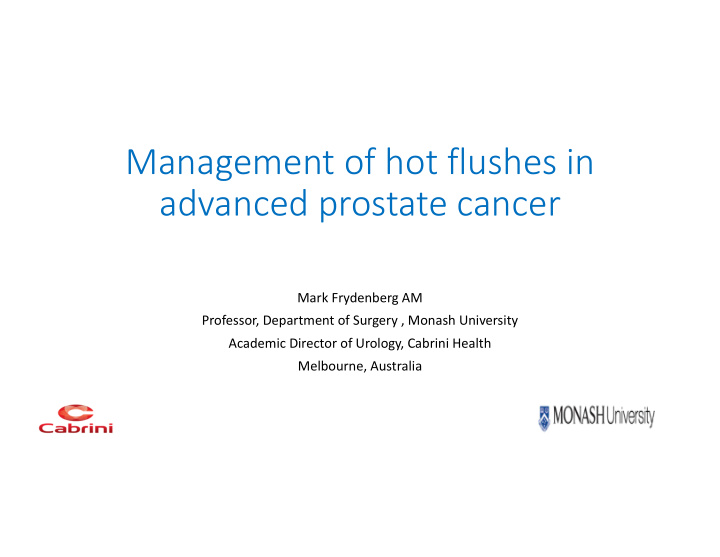



Management of hot flushes in advanced prostate cancer Mark Frydenberg AM Professor, Department of Surgery , Monash University Academic Director of Urology, Cabrini Health Melbourne, Australia
• Subjective feeling of warmth , upper torso, followed by excessive perspiration • 80-90% of men on ADT, 27% report them as most troublesome side effect • Variable sympathy • Associated with patient distress during treatment, embarrassment and helplessness Ulloa Psycho-oncology 2009 • Can last for the duration of therapy, effect QOL and sleep quality Karling et al., J Urol 1994, Nishiyama et al., Int J Urol 2004, Freedman Am J Med 2005, Penson et al., J Urol 2003
• Congenital hypogonadism does not lead to hot flushes • As such it is not absolute plasma sex hormone level that is critical but its reduction from previously normal levels that alters the function of brain neurotransmitters such as noradrenalin , serotonin, GABA, dopamine and beta endorphins.
• Thermoregulatory centre in the hypothalamus is anatomically close to the LHRH secreting neurones and by proximity the thermoregulatory centre can be reset. • Positive correlation between flushes and LH surges • Worsens with duration of ADT • Worse in men of younger age and lower BMI Gonzalez et al., J Urol 2015
Conservative management • Avoid thermogenic stimuli – keep diary of triggers and avoid them e.g., alcohol, tobacco, caffeine , spicy foods • Assess degree of bother , recent study demonstrated that 42% did not enter trials as not bothersome enough Zarkadoulias et al., Eur Urol 2014
Conservative management • Environmental cooling at night, fans , open windows • During day - dress in layers , open weave fabrics e.g., cotton
ADT manipulation • Intermittent androgen blockade Botrel et al., BMC Urol 2014, Brungs et al., PCPD 2014, Hussain NEJM 2013 • Hot flushes peak 4 months after initial LHRH agonist administration (3 weeks after bilateral orchidectomy) • Mean time to cessation of flushes with IAB was 7.6 months Dosani et al., Clin Oncol 2018 • Studies have shown flushes with LHRH antagonist > agonist but only for first 3 months then equalises Sokolakis et al., Eur Urol 2014 • Role of anti-androgen monotherapy rather than GnRH agonist? Beckmann et al., Eur Urol 2019
Medical treatments • Oestrogens • Centrally reduces LH surges • DES 0.25-0.5 mg/day eliminated hot flushes in 70%, 20% had > 50% reduction • Also achieved with 0.10 mg/hr transdermal DES Gerber et al., Urology 2000, Atala Urology 1992, Miller et al., Urology 1992 ; • SAE thromboembolic and effectiveness and side effects are dose dependent • Study using ER alpha agonist GTx758 instead of LHRH reduced hot flushes whilst maintained drop in testosterone Yu et al., Eur Urol 2015
Medical treatments • Alpha 2 adrenergic blockers • Clonidine , oral or transdermal , 1 mg/day, receptors centrally and peripherally • Not effective ; 30-40% reported partial responses and another study no difference to placebo Smith et al., J Urol 1994 Loprinzi, Mynderse et al., J Urol 1994 • SAEs: constipation , dizziness, drowsiness and dry mouth, fatigue and weakness
Medical treatments • Progesterone/Progestins • Reduces LH surges centrally • Cyproterone acetate (Androcur 50 mg daily and titrate upwards), medroxyprogesterone (Provera 150-400 mg), megestrol acetate (Megace 20 mg BD) , • Reduces hot flushes by 70-80% but potentially hepatotoxic, fatigue and gynaecomastia Eaton Lancet 1983, Cerveakov et al., Int Urol Nephrol 2000, Loprinzi et al., NEJM 1994, Thrasher et al., J Urol 2005,
Medical treatments • SSRI, SNRI anti depressants • Venlafaxine (Efexor, SNRI) 75 mg per day , Paroxetine (Aropax, SSRI) used in various doses , usually 10 mg/day • ~ 60% improved symptoms, > 50% improvement in hot flush score • SAEs: nausea, anorexia, headaches, agitation ; • RCTs comparing venlafaxine to progesterones, concluded hormonal therapies were more effective than SNRI/SSRIs • Venlafaxine -47%, Cyproterone acetate -94.5%, Medroxyprogesterone acetate -83.7% Quella et al., J Urol 1999, Irani et al., Lancet Oncol 2010
Medical treatments • Gabapentinoids – gamma aminobutyric acid analogues, gabapentin 900-2400 mg/day (Neurontin), pregabalin 75-150 mg BD (Lyrica), antiseizure, used for neuropathic pain, 25% reduction in hot flushes – light headedness and drowsiness, Loprinzi et al., J Clin Oncol 2010, Bordeleau et al., J Clin Oncol 2010 • Oxybutynin – used in women, 70% favourable response in a group refractory to other treatments Sexton et al., Menopause 2007
Complementary treatments • Exercise - some evidence high intensity aerobic and resistance training helps women reduce flushes during menopause by 40-50%, no data in men • Cognitive behavioural therapy • Diet -phytoestrogens/soy – No benefit in RCTs Steams et al., Lancet 2002, Sharma et al., J Urol 2009 • Acupuncture – 70-80% reduction in flushes with either dry needling or electro-stimulated needling • Maintained < 50% reduction in flushes 9 months after cessation of treatment in 46% Frisk et al., Eur Urol 2008 • 89.2% reduction at 6 weeks, maintained at 80.3% at 8 months Ashamalia et al., Int J Radiat Oncol Biol Phys 2011
Conclusions • Common and troublesome side effect of ADT • Avoid triggers • Promote conservative therapies – fans, light clothes … • Intermittent androgen blockade where appropriate and safe to do so • Consider progesterones (cyproterone acetate), and/or SSRI/SNRI antidepressants as first line medical therapy • Complementary therapies – acupuncture, exercise • Significantly under-researched area
Recommend
More recommend